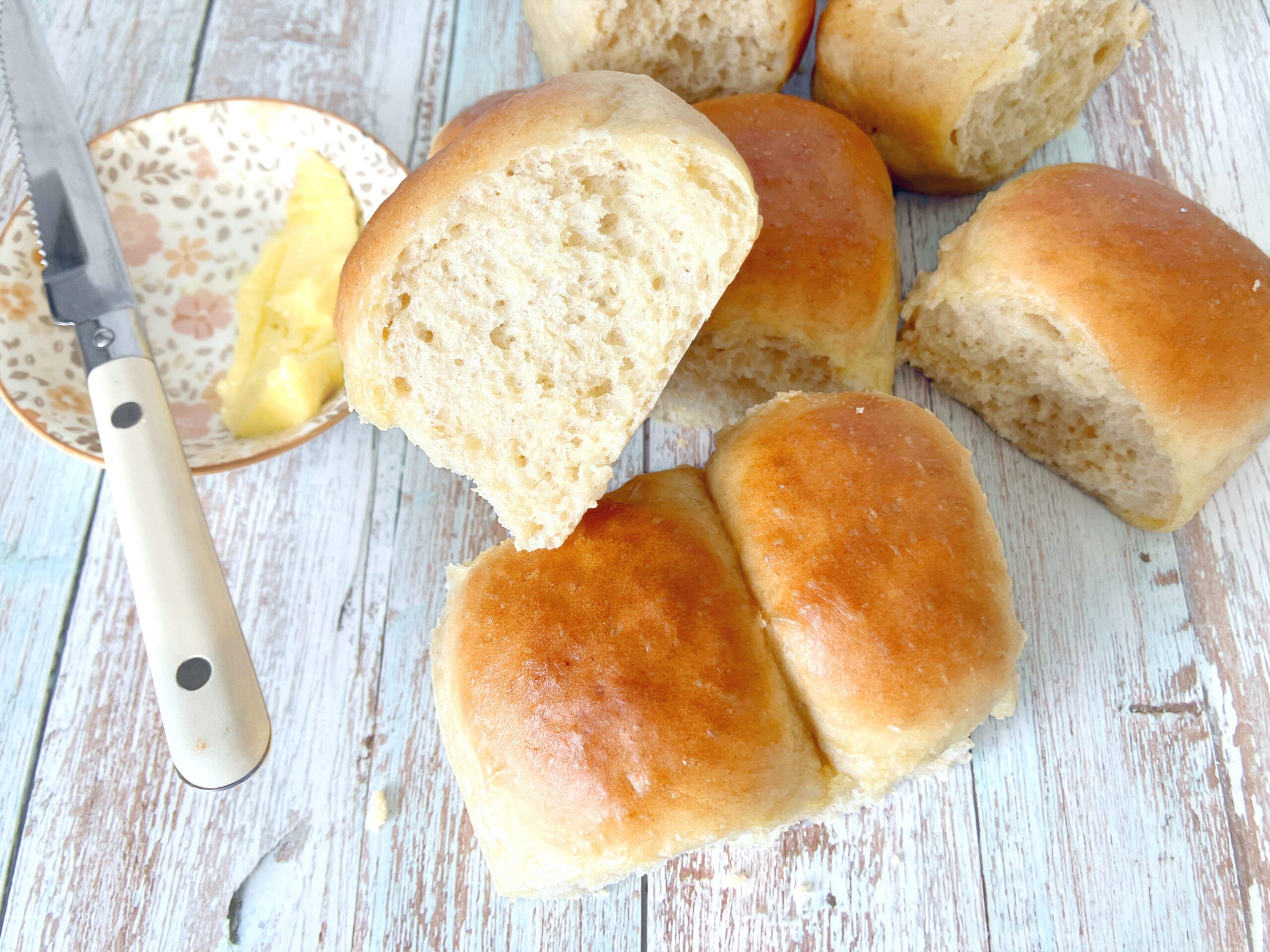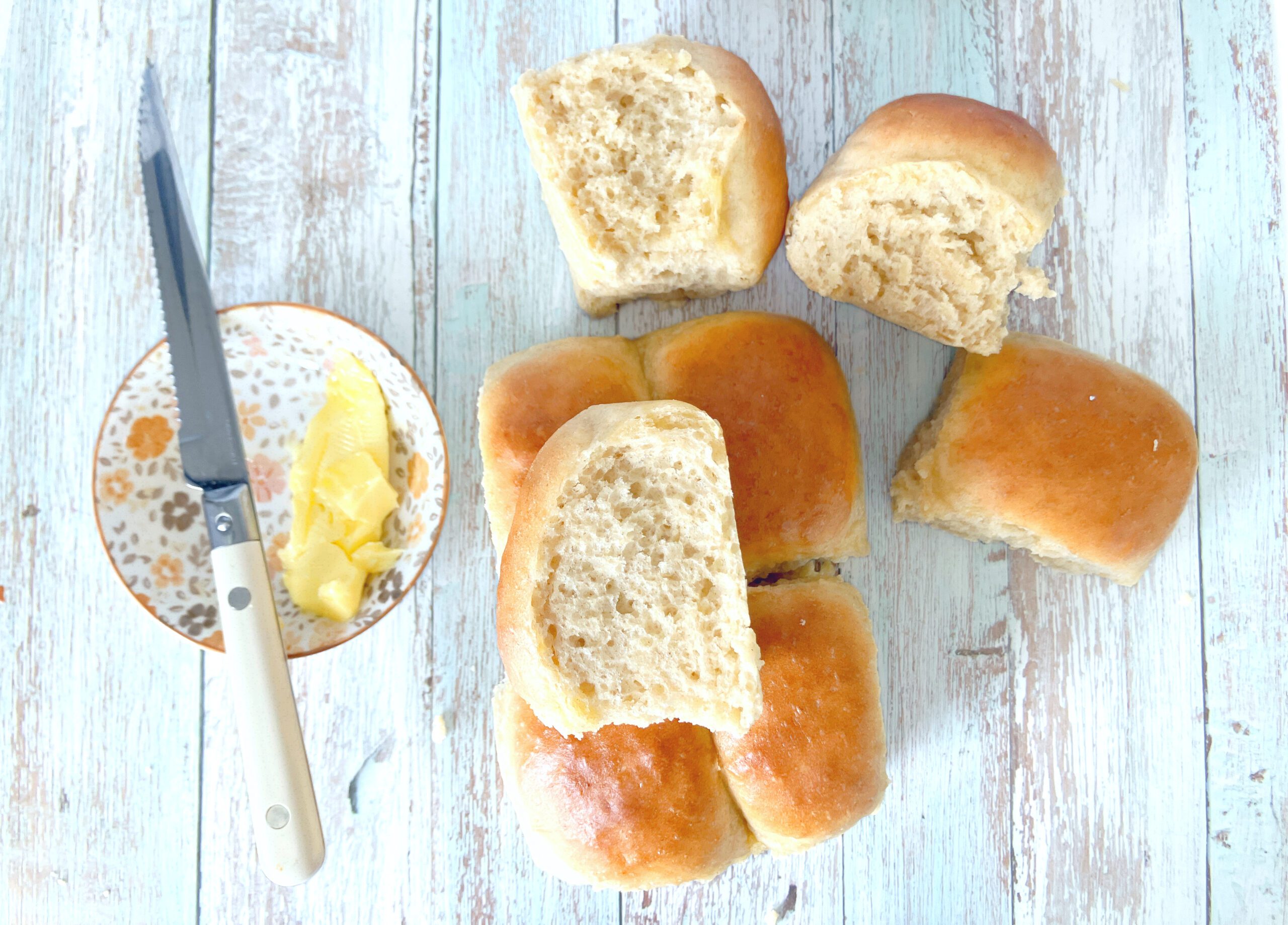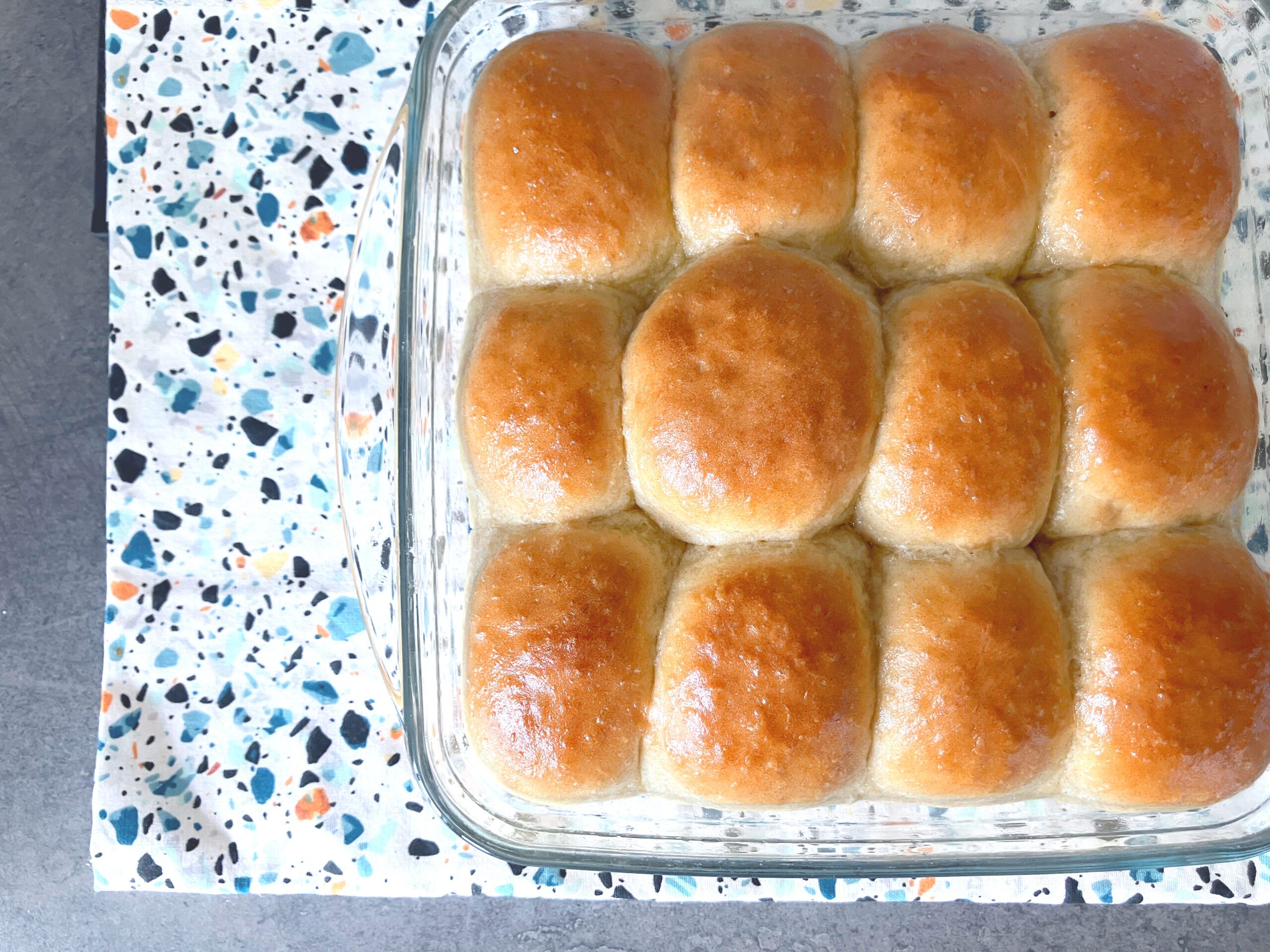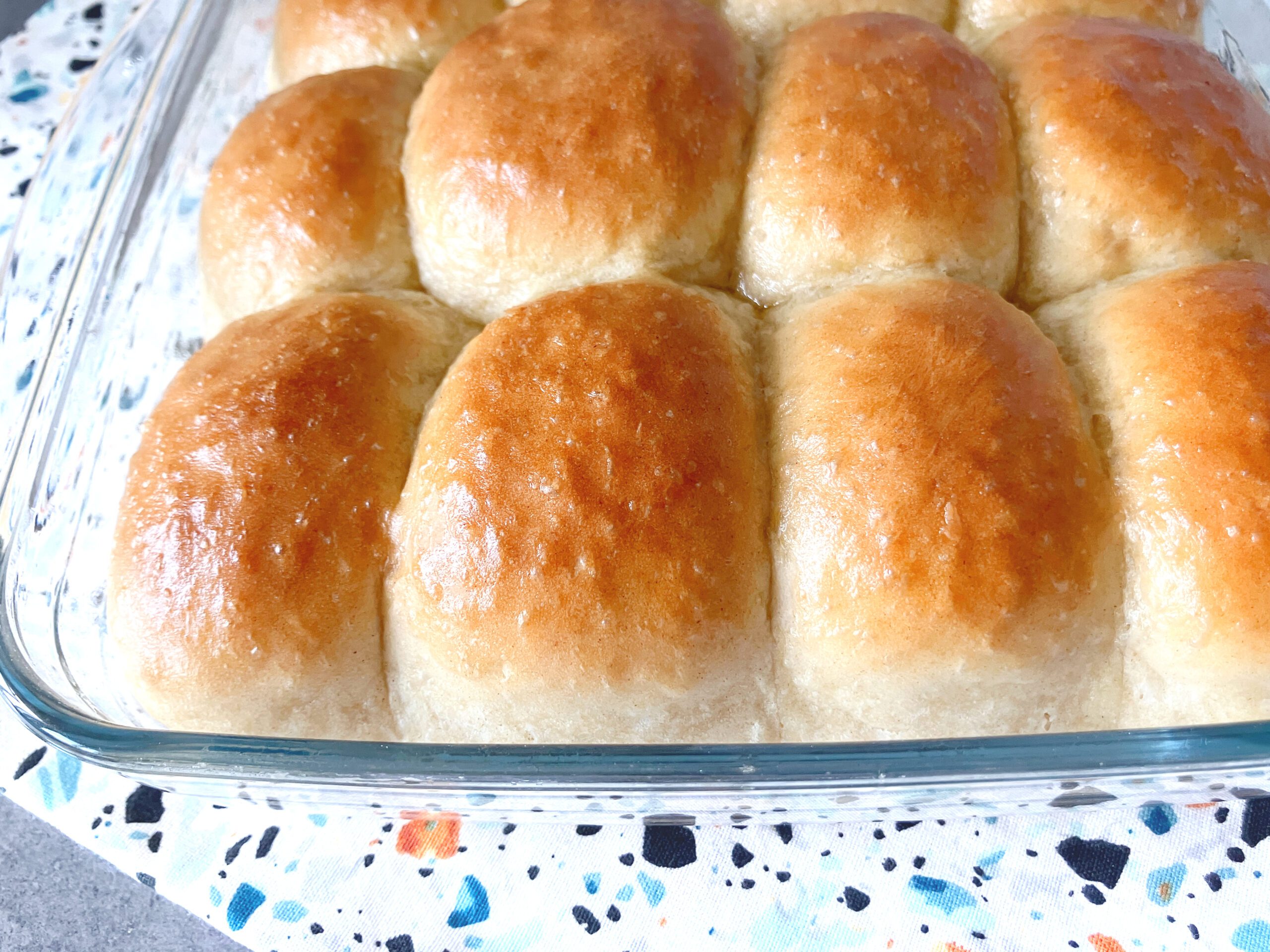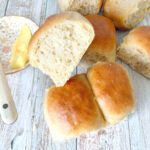One Hour Spelt Dinner Rolls
These dinner rolls are perfect when you’re in a rush and want warm, homemade bread on the table fast. Soft, fluffy, and ready in about an hour, they’re ideal with dinner, but just as good filled with tuna mayo or dipped into soup. And they freeze beautifully, too.
One hour spelt dinner rolls
If you’ve ever wanted homemade bread on the table without spending the whole afternoon in the kitchen, this is the recipe for you. These soft, pull-apart rolls are made with white spelt flour and are ready in about 60 minutes, including rising and baking.
What makes these so quick? A few things. First, we warm the milk and butter slightly before adding it to the dough. That little bit of warmth helps the yeast spring to life, cutting down rise time significantly. The dough also uses a full 7g sachet of dried yeast, which gives the dough a quick boost.
Another time-saver is using a stand mixer. Spelt dough is delicate and benefits from gentle but consistent kneading. The mixer handles that easily, leaving you to prep the rest of your dinner while it works.
These rolls are enriched with milk, butter and an egg for a pillowy-soft crumb. I also used maple syrup to lightly sweeten the dough. The result is a soft, springy bread roll that works well alongside dinner, but is just as lovely with a smear of butter or stuffed with sandwich fillings.
What are dinner rolls?
In the UK, the term “dinner rolls” isn’t something we hear all that often. We absolutely serve bread with meals, think naan with curry, garlic bread with spaghetti bolognese, or a hunk of crusty focaccia dunked in soup, but the idea of placing a basket of small, soft rolls on the table feels distinctly American to me. I always picture a gingham cloth, a rustic wooden table, and someone from Little House on the Prairie passing them around with a ladle of stew.
Still, the appeal is obvious. A warm, fluffy roll to go with your dinner. Yes, please. And while the term may not be part of my everyday vocabulary here, the concept certainly isn’t foreign. In fact, bread rolls of all kinds have long been part of European food culture, from German Brötchen to French petits pains. These small portions of bread made it easy to serve something fresh with each meal, especially before sliced bread became the norm.
In the United States, dinner rolls became a mainstay of the home-cooked meal in the 19th and 20th centuries. Recipes often featured in community cookbooks, and they were, and still are, a key part of celebratory meals like Thanksgiving. Soft, enriched rolls, brushed with butter and baked close together in a tin so they rise into each other, became the iconic “pull-apart” dinner roll I associate with American cuisine. And while I may not have grown up calling them dinner rolls, I’ve absolutely embraced the tradition, especially when I can make them this quickly.
Less flour is more when making spelt bread
Spelt flour doesn’t behave like regular wheat flour. Its gluten is weaker and more delicate, so it doesn’t need as much kneading, and it’s easy to add too much flour if you’re expecting the same kind of structure as white bread dough. At first, the dough might feel very soft or even too wet, but as you work it, it naturally tightens up without needing extra flour.
Start with 300g of white spelt flour (about 2.5 cups) and add more only if it’s truly necessary. You’re aiming for a dough that pulls away from the sides of the mixing bowl and slowly drops from the dough hook in one smooth piece. It will still be sticky, but that’s normal. Turn it out onto a well-floured surface, dust the top with flour, and use the flour more as a barrier than an ingredient, just enough to help you shape the dough into balls.
If you’re new to spelt flour, and would like some handy tips, be sure to read my tutorial: The Beginner’s Guide to Spelt Flour.
Using maple syrup in bread dough
Right now I’m avoiding refined sugar, so I chose to use maple syrup in this recipe. You can easily substitute it with white sugar if you prefer, or leave the sweetener out altogether. A small amount of sugar in bread dough isn’t just for sweetness, it feeds the yeast, helping it activate more quickly and encouraging a better rise. This means your dough gets going faster and can develop more flavour.
Maple syrup works beautifully as a natural sweetener here. Because it contains minerals and antioxidants, it adds a subtle depth and complexity to the flavour of the bread that white sugar can’t quite match. It also helps create a softer crumb and a slightly tender crust. If you omit any sweetener entirely, your rolls will still rise, but they might take a little longer and lack that faintly sweet note that makes homemade bread so comforting.
What yeast should I use?
Yeast terminology can be confusing because different countries use different names and forms, and the way you use them varies. In Sweden, we commonly use torrjäst, or dried yeast, which can be mixed directly into the flour without needing to be dissolved first. This is very similar to what Americans call instant yeast or rapid-rise yeast, both are designed to be added straight to dry ingredients without proofing.
If you’re using active dry yeast, which is more common in the US and sometimes just labelled “dry yeast,” it’s a bit different. This yeast needs to be dissolved in warm liquid like milk or water with a pinch of sugar, as this will wake it up before adding it to your dough. Otherwise, it might not activate properly and your bread won’t rise as expected.
If you prefer to use fresh yeast (also called cake yeast or compressed yeast), you’ll want about 25 grams for this recipe. Fresh yeast should always be dissolved in the warm milk mixture first to activate it before mixing with the flour.
I’ve used both dried and fresh yeast for these spelt bread rolls and found no discernible difference in the final result. So feel free to use whichever you have on hand. The important part is how you incorporate it into the dough.
To summarise, dried yeast or instant yeast can be mixed straight with the flour, while active dry yeast or fresh yeast need to be dissolved in warm liquid first.
Brushing the bread rolls with butter
If you want soft, shiny rolls with a rich flavour, don’t skip the final step, brushing them with butter straight after they come out of the oven. While an egg wash or a splash of milk before baking can give your rolls a lovely golden colour, it’s the melted butter brushed on warm rolls that creates that irresistible shine and softens the crust.
The butter not only adds a beautiful glossy finish but also enhances the flavour, giving the rolls a subtle richness that’s hard to beat. Plus, it keeps the crust tender, so the rolls stay soft longer.
For best results, gently melt the butter until it’s fully liquid but not hot, then brush it generously over the warm rolls. You can even do a second light brushing once they’ve cooled slightly for extra shine and flavour.
Not just for dinner
Even though these are called dinner rolls, they’re far too versatile to be limited to a side hustle. My son once devoured four in one sitting, filled with tuna mayonnaise and red onion. Their soft, fluffy texture is proof that they also make excellent sandwich buns as well as a dinner accompaniment.
They’re also great for quick snacks or packed lunches. Toast them lightly and add your favourite spreads, cheese, or cold cuts for an easy, satisfying bite. They are perfect for a picnic, day on the beach, or a lunch on the go.
Freeze the leftovers
Spelt bread, like all homemade bread, dries out quickly and loses its fresh texture within a day or two. To keep these dinner rolls tasting as soft and delicious as the day you baked them, I always freeze any leftovers right after they’ve cooled completely.
Freezing helps lock in the moisture and freshness. When you’re ready to enjoy them, simply reheat in the oven or microwave. Just a few minutes will bring back that warm, fluffy texture.
One Hour Spelt Dinner Rolls
Ingredients
- 175ml (¾ cup) milk
- 30g (2 tbsp) butter
- 1 tbsp maple syrup
- 300-360g (2½ - 3 cups) white spelt flour (see note 1)
- 1 tsp sea salt
- 7g (2¼ tsp) dried yeast (see note 2)
- 1 egg (around 60g)
- 1 tbsp butter (for the dish, and for brushing after baking)
Instructions
- Melt the butter, milk and maple syrup together (about a minute in the microwave), just until the butter is mostly melted. Stir and leave to sit for a minute.
- Add 300g (2½ cups) flour, yeast and salt to your stand mixer bowl.
- Add the butter mixture along with the egg.
- Mix everything together, adding more flour as needed (see note 3).
- The dough is ready when it has pulled away from the sides of the bowl and falls slowly from the hook when lifted.
- Cover the dough and leave to rise for 30 minutes.
- Preheat the oven to 175℃ (350℉).
- Melt the additional butter and brush some over your dish – mine is 20cm x 20cm (8" x 8"). The rest will be used to brush over the bread after baking.
- On a very well floured surface (I use a silicone mat), pour out the dough. Cover with more flour, but don’t work it in.
- Divide into 12 equal-sized pieces and roll them into rough balls. Use a little flour on your fingers if the dough is sticky.
- Place the balls right next to each other (without much space) so the dough rises upwards rather than spreading out.
- Bake for 14-17 minutes until golden brown on top.
- Brush with butter and leave to cool slightly. Enjoy!
Notes

